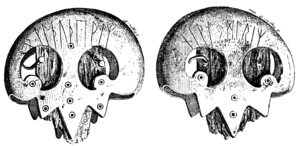

The Thorsberg chape[1] (a bronze piece belonging to a scabbard) is an archeological find from the Thorsberg moor, Germany, that appears to have been deposited as a votive offering.[2] It bears an Elder Futhark runic inscription, one of the earliest known, dating to roughly 200 CE.
Archaeologists believe it was made in the region between the Rhine and the Elbe.[2][3][4]
ᛟᚹᛚᚦᚢᚦᛖᚹᚨᛉ
owlþuþewaz
/
/
ᚾᛁᚹᚨᛃᛖᛗᚨᚱᛁᛉ
niwaje͡mariz
"Wolthuthewaz is well-renowned," or "the servant of Ullr, the renowned."
The first element owlþu, for wolþu-, means "glory," "glorious one," cf. Old Norse Ullr, Old English wuldor. The second element, -þewaz, means "slave, servant." The whole compound is a personal name or title, "servant of the glorious one" or "servant/priest of Ullr." On the reverse, ni- is the negative particle, waje- corresponds to "woe, ill" (Old Norse vei), and the final element is -mariz "famous" (Old English mǣre). (The "e" and "m" are written together, as a bind-rune, an unusual early example but probably not linguistically significant.[5]) The second word thus translates to "not ill-famous," i.e., "famous, renowned" or "not of ill fame, not dishonored." Similar double negatives are found on other runic inscriptions.[2] The translation of the inscription can thus be either "Wolthuthewaz is well-renowned," or "the servant of Ullr, the renowned." If the first part refers to the god Ullr, it is the only reference to that god from south of Denmark, and also, if a personal name, the only German example of a person named for a specific Germanic god.[4]
Another reading, avoiding the emendation of the first element, reads the first letter ideographically, "Othala," resulting in o[þalan] w[u]lþuþewaz / niwajmariz "inherited property of Wulthuthewaz, the renowned." However, the owner's name is not in the possessive case as would be expected with such a usage; moreover, the rune Fehu, signifying simply "property," would be more apposite; "Othala" can specifically denote real estate.[6]
It is possible that the inscription is poetic; it can be read as an alliterative long-line.[7]
YouTube Encyclopedic
-
1/3Views:1 0969 5005 030
-
Ull, The Enigmatic Forgotten God of... Skiing?? (Norse Mythology)
-
Ullr True Meaning: Translation, Attestations, Theories of Norse Gods/Deities
-
Ancient Knowledge - ( part 5) HD
Transcription
See also
Notes
- ^ "Runic inscription DR 7". Scandinavian Runic-text Database (2020 ed.). Uppsala University: Department of Scandinavian Languages.
- ^ a b c Tineke Looijenga, Texts & Contexts of the Oldest Runic Inscriptions, Leyden/Boston: Brill, 2003, ISBN 90-04-12396-2, p. 259.
- ^ Hans Frede Nielsen, "The Dialectal Provenance of the Gallehus Inscription," in Von Thorsberg nach Schleswig: Sprache und Schriftlichkeit eines Grenzgebietes im Wandel eines Jahrtausends: internationales Kolloquium im Wikinger Museum Haithabu vom 29. September–3. Oktober 1994, ed. Klaus Düwel, Edith Marold, and Christiane Zimmermann with Lars E. Worgull, Reallexikon der germanischen Altertumskunde Ergänzungsband 25, Berlin: De Gruyter, 2000, ISBN 3-11-016978-9, pp. 25-36, p. 31.
- ^ a b Henrik Williams, "From Meldorf to Haithabu: Some Early Personal Names from Schleswig-Holstein," Von Thorsberg nach Schleswig pp. 149-66, p. 157.
- ^ Mindy MacLeod, Bind-Runes: An Investigation of Ligatures in Runic Epigraphy, Uppsala: Institutionen för nordiska sprak, Uppsala Universitet, 2002, ISBN 91-506-1534-3, p. 51, note 17.
- ^ Williams, p. 156.
- ^ Tonya Kim Dewey, Versatility in Versification: Multidisciplinary Approaches to Metrics, Berkeley Insights in Linguistics and Semiotics 74, New York: Lang, 2009, ISBN 978-1-4331-0578-4, p. 7.
